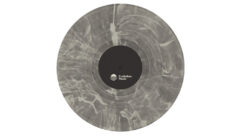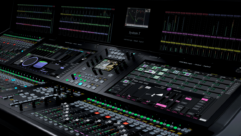Sweet, Sweet Music
Jan 1, 2003 12:00 PM,
Richard Honeycutt
Choosing and positioning choir microphones is one of the most challenging aspects of sound-system design and installation for traditional worship centers. Installations in many churches seem to indicate that the installers were blissfully ignorant or simply guessing. The good news is there is a right way to choose and use choir mics, and this article will point you in that direction.
THE SOURCE
Because you want choir mics to pick up the human voice, it’s important to know something about the acoustics of the human vocal system. First, where does the sound come from? Remember that a voice instructor will tell you that there are head tones, throat tones, and chest tones. So the easy answer — sound comes from the mouth — is not entirely true.
Head tones comprise the upper part of the vocal range and are radiated from the mouth and nose. If you use a hypercardioid mic in tonsil position — aimed downward at the mouth — the person singing will sound as though he or she has a cold, because of the lack of nose sounds. Throat tones are in the middle part of the range and come from the mouth and the throat. Think about how someone sounds with a flat-response lavalier mic (not ramped or peaked as most are), positioned actually at the throat.
Chest tones, like the name implies, come mostly from the chest. These are the hardest to pick up with a solo mic because they radiate from a large area; thus the mic would have to be located several feet from the singer in order to pick up the sound accurately. Many sound techs have noticed that sopranos are much easier to pick up accurately than altos, and that is true because of the relatively greater proportion of chest tones in the alto’s sound. For the same reason, bass singers tend to sound thin when miked.
The other crucial bit of knowledge about the human sound source are the directional characteristics. The lower frequencies are pretty much omnidirectional, radiating equally to the front, back, top, and sides of the body. But most of the vocal quality relates to the harmonics, which are higher-frequency components. Fig. 1 shows a simplified diagram of the directional characteristics of a human singer or speaker. Standing 20, 50, or 100 singers side by side will not change the directional pattern.
THE ACOUSTIC ENVIRONMENT
When you set up the sound system for the Great Worship Service in the Sky, the choir will be made up of professionals who recognize that the sound tech is their friend, and the choir loft will be sound friendly. That means the ceiling will be reflective to help the choir members hear each other. The ceiling will not be too high, so the reflections will reinforce the sound of the choir rather than being bothersome echoes. The wall behind the choir will also be reflective to help project the natural sound of the choir toward the congregation. The floor of the platform in front of the choir will be hardwood to reflect the vocal sound, which is aimed down toward the congregation. The floor under the choir members’ feet will be carpeted to reduce foot-shuffling noises.
For now, however, you must work in this world, in which conditions are not always so perfect. So why bother knowing what perfection would look like? From time to time, you may have the opportunity to talk with a person or group that is planning a new facility. You can show them proven ways to optimize the acoustics of the new sanctuary, and for a reasonable fee, you will advise them. An alarming number of architects, building contractors, and worship leaders think that because they do not understand the science of acoustics, nobody else does.
The other thing you can do is to see whether there are any possible acoustical improvements that you can influence. If heavy drapes are used beside or behind the choir, suggest their removal. If there is an acoustical ceiling above the choir, ask to have it replaced with something less absorptive. The goal, as always, is good sound. Anything you do to improve the natural sound of the choir will better the sound you get through the mics.
MIC REQUIREMENTS
When selecting mics, think about what you want the mics to do. First, the mics should pick up all the choir members evenly, and they should reject any sounds not coming from the choir. The mics need to have accurate frequency response and should have very low self-noise. Finally, the mics should be invisible to the congregation.
Of these requirements, the minister of music is most concerned with picking up the choir members evenly. The sound tech wants the mics to reject nonchoir sounds, and the congregation, the tape ministry listeners, and so on will notice inaccurate frequency response. The engineer at the radio or TV station, if the services are broadcasted, will be looking at mics with low self-noise, and the church committee will likely be concerned with the mics being hidden from view.
Some of these requirements conflict with each other. The mic’s directionality could bring the desires to capture each choir member and reject other sounds into conflict. Fig. 2 shows the most common mic directional patterns, along with the acceptance angle for each.
Most often, meeting both of these requirements involves using cardioid or hypercardioid mics. However, there are other considerations. Most microphones designed for choir pickup have reasonably flat frequency response, which is certainly not true of mics designed for handheld vocal use. Fig. 3 shows the response curve for the Shure SM57, a popular vocal microphone. The intentional hump, called the presence peak, is just above 5 kHz.
Also, notice the low-end rolloff. These characteristics were deemed to enhance the sound of the mic in the ’70s, when it was designed. Perhaps it does, because the example mic works well and has been very popular for handheld use. But it was not designed for choir pickup, and if used for that function, it will sound as you would expect from the frequency response curve — somewhat thin.
Fig. 4 shows two frequency response curves — omni and cardioid versions of a popular choir mic, the Countryman Isomax 2. Notice that the cardioid version has a more restricted low-frequency response and a bit of a hump in the high end. Neither of those characteristics will make much difference if the mics are only picking up a choir. But if they will also be used for orchestral pickup, you may notice the difference. So there you have a potential conflict, small though it may be, between the directional requirements and the response requirements for a choir mic. Omnis are always the flattest and have the best low-end response, but usually a directional mic is preferred for rejection of extraneous sounds and feedback.
Another conflict involves self-noise. The self-noise of a mic is a combination of the electrical noise of the capsule and internal FET as well as the noise of random air motion near the diaphragm. The self-noise is pretty much the same among all high-quality condenser mics, which is what the good choir mics are. But the important thing is the signal-to-noise ratio, which is the ratio of the mic’s output voltage at a certain sound level to its self-noise voltage. Condenser mics with larger capsules produce a higher output, so they have a higher signal-to-noise ratio. That means that the mic channel does not have to be turned up as loud, so the noise is less audible.
However, large-format condenser mics tend to have resonances in the audio range that color the sound. Some of that coloration is considered desirable in vocal solo mics, and that is why large-format condenser mics are highly favored for vocal pickup in studios. But for choirs, the coloration is usually not so desirable, not to mention the fact that the larger size is guaranteed to elicit interference from the church committee.
The end result is that you’ll probably use mics designed specifically for choir use by Countryman, Electro-Voice, Shure, Audio-Technica, DPA, Sennheiser, and others. The mics come in two basic shapes: one is a small cylinder that uses a specially shaped wire fixture to point the mic at the choir, and the other is a tiny rectangle that is active on one face (or both faces, in the case of a bidirectional model). The rectangular models are less visible from a distance, especially when purchased in a color to match the walls, but they sometimes require a bit of ingenuity to keep them from rotating as the cable from which they are suspended gradually relaxes.
Both shapes of choir mics can be used with small foam windscreens, but these are seldom needed unless the mic must be hung in the stream of a heating/air-conditioning vent.
MIC POSITIONING
A suspended mic is not in the ideal position to pick up voices that have the directional pattern shown in Fig. 1. Unfortunately, the other options are usually worse.
Footlight mics (such as the Countryman DBM or the various pressure-zone or boundary mics) are a bit too low for optimum pickup but are better positioned than suspended mics. However, footlight mics are liable to be stepped on or kicked or will pick up footstep noise. The church committee might also decide to place a huge potted plant just in front of the mic.
Stand mics can be positioned at the exactly correct location but are subject to the same problems as footlight mics, and they’re visually distracting. In addition, stand mics experience comb filtering when used with distant sources (more than a foot or so) because of interference between the direct sound and the sound reflected from the floor. That imparts a hollow, unpleasant sound quality.
So you are usually stuck with suspending the mics, even though you know that it will put them off-pattern for the singers’ voices. But where exactly do you put them? First, there must be even pickup of all the choir members and no overlap of various mics’ pickup patterns. The mics must be as close to the choir as possible for the best presence and highest gain before feedback, and they need adequate clearance above the floor for physical safety.
The direct sound from a choir member will decrease at a rate of 6 dB with doubling of distance outdoors or in an absorptive room. If the choir loft’s design is acoustically sound, with reflecting surfaces close to the choir, the decrease will be less than 6 dB. But to be conservative, use the 6 dB figure. That means that if Albert is twice as far from the mic as Alice, Alice’s voice will be 6 dB louder in the mix. Not knowing Albert and Alice, you cannot state whether that is a good thing or not. However, you generally want each voice to come through equally. The table “Distance Variation Versus Decibel Imbalance” shows the ratio of nearest-to-farthest distances from choir member to mic that correspond to various decibel values of imbalance.
Thus if you insist upon having the various choir members’ voices picked up evenly, within 2 dB of each other, and the one nearest the mic is located 10 feet away, the one farthest from the mic must be no more than 1.26 × 10.00 = 12.60 feet from the mic. As you will appreciate, that can be challenging to arrange. In fact, it turns out that about a 6 dB variation is pretty much the best you can design for.
When two mics are positioned so that they both pick up the same sound source, there will be interference between the mics’ output signals when they are mixed. At any given frequency, the difference in path length from the source to the two mics will translate into a phase difference in their outputs. That phase difference will cause the signals at some frequencies to add while at other frequencies, they cancel. The resulting frequency response plot is a series of alternating peaks and dips that look like a comb; hence, this problem is called comb filtering. Comb filtering sounds weird and decreases gain before feedback.
About 22 years ago, my company installed the sound system in a new church. In this church, the pastor was in charge. He wanted even choir pickup — he knew nothing about mics — but absolutely insisted that we use five mics to cover a 35-foot-wide choir loft. The result was as bad as I told him it would be, and I convinced the operator that he should not use all the mics at the same time. Thus the comb filtering was kept somewhat under control while giving the pastor what he insisted upon.
The general guideline for avoiding comb filtering is that the distance from a given source to the nearest mic should be less than one-third the distance from that source to any other mic. In choir miking, that is usually an impossible condition to achieve. The best you can do is to use the fewest mics as possible and design for a small gap in coverage between mics. In other words, separate the two mics a bit too far for even coverage. The result is that the singers whose voices are subject to comb filtering are not picked up as strongly as the others, which reduces the sound degradation caused by the comb filtering. That approach also reduces the physical width of the comb-filtered region of the choir. (If you tell the minister of music what you’re doing, he or she can often use this gap to advantage by placing the self-appointed divas in those locations.) Naturally, the fewer mics you use, the farther they have to be from the choir to get even pickup. So again you have a conflict in design goals.
Just what is adequate clearance for the choir mics’ physical safety? A few church members may be very tall, and you don’t want anyone’s head bumping the mic. Also, wedding directors like to place burning candles directly under the choir mics, so some height is needed to avoid cooking the mics.
RECOMMENDATIONS
Don’t hang the mics directly above the choir. Actually, you can get pretty even pickup from there, but the sound is awful. Try holding a mic above a singer’s head — you’ll hear the awful sound.
Fig. 5 illustrates the placement of a choir mic, with the important distances labeled. It turns out that dimension Z, the depth of the choir (front row to back row), is important. To pick up each member, with a variation under 6 dB, the mic should be about 8 feet from the floor and the horizontal distance Z from the front row to the mic should be about 1.4 times Z. If more than one mic is used, the distance between the mics (X2) should be 2.9 times Z for even pickup of the front row. That will give a bit of a gap for the rows behind the front, as discussed previously.
For more of a gap, you can space the mics a bit farther apart, but the 2.9(Z) works well in most cases. If the floor of the choir loft is angled, you can raise the mic to nine or ten feet and move it a foot or two closer to the choir. The mic should be no farther than 1.2(Z) from the end of the front row (dimension X1). The reason that the distance between mics should be more than twice the distance from a mic to the end of the row is that the choir members between the mics are picked up by two mics.
This arrangement lets each mic cover a distance of about 2.65(Z) of the choir width. For a choir arranged in four rows, the depth of the choir is about 10 feet, so each mic would cover about 26.5 feet of choir. A hypercardioid mic will provide just enough coverage, but if the small rear lobe of a hypercardioid is a problem, you can use a cardioid mic. An omni is okay for recording but will have less presence, and it will provide less gain before feedback in a sound-reinforcement application.
Hanging the mic 14 feet horizontally from the front of the choir might seem too far away. That would be true if the choir has only one or two rows. But as the choir depth increases, the distance from the mic to the singer in the back corner becomes proportionately greater than the distance from the mic to the nearest singer, and that back-corner singer begins to disappear from the mix. The distance from the mic to the front row really has much less effect on the balance among singers in the front row than it does on the balance of front row to back corner.
You can use more mics to improve overall side-to-side balance, but remember that you will be introducing comb filtering in the area of the choir where the mics’ pickup ranges overlap. Usually, any improvement in evenness of coverage is more than offset by the results of the comb filtering.
For recording only, you can place the mic farther from the front row of the choir and you will get less variation. A maximum variation of 2 dB requires the mic to be about 4.2(Z) in front of the choir, which is pretty far away. But sometimes you can get away with it in an acoustically dead room.
Using those guidelines, you can be sure that the choir pickup will be as even and natural as possible, you will have a sense of a job well done, and your company’s reputation will be enhanced. Maybe even the chairperson of the church committee will contact you for a system rental for the Spring Flower Show!
Richard Honeycutt has worked as an engineering technical writer, a college electronics instructor, a professional musician, a broadcast radio engineer, and a sound engineer. He is a contributing editor for Voice Coil magazine, a sound-system designer, and a consultant in electroacoustics.










